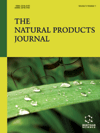
Full text loading...
We use cookies to track usage and preferences.I Understand

Peperomia pellucida is a medicinal and vegetable plant used worldwide, representing a multi-purpose vegetable with applications in the pharmaceutical, food and cosmetic industries.
This study evaluated the antioxidant, antibacterial, antifungal, anti-inflammatory, and antidiabetic potential of fractional extracts from P. pellucida plant derived from Can Tho City, Vietnam.
Four fractional extracts were prepared using different polarity solvents (hexane, dichloromethane, ethyl acetate) and used to determine the best extract for each biological property. The fractions’ total alkaloid, phenolic, and flavonoid content were observed. The four extracts were evaluated for their potential bioactivities: antioxidant, antibacterial, antifungal, anti-inflammatory, and antidiabetic.
Correspond with the hexane, dichloromethane, ethyl acetate, and aqueous fractions, the total content of alkaloids was determined to be 255 ± 23.8; 157 ± 14.0; 219 ± 6.55; 221 ± 6.23 (mg AE/g extract), the total phenolic content was 112 ± 3.34; 141 ± 1.77; 234 ± 29.5; 123 ± 5.04 (mg GAE/g extract), whereas the total content of flavonoids was 84.49 ± 4.53; 33.77 ± 1.26; 367.8 ± 3.37; 34.49 ± 4.53 (mg QE/g extract), respectively. The ethyl acetate fraction gave the best efficiency in DPPH, ABTS, iron reduction, and TAC methods (IC50 = 334 ± 2.10 µg/mL; 51.4 ± 0.41 µg/mL; 79.1 ± 0.40 µg/mL; and 83.0 ± 0.17 µg/mL, respectively). Antibacterial activity was investigated on 5 strains of Bacillus cereus, Escherichia coli, Staphylococcus aureus, Salmonella typhimunum, Pseudomonas aeruginosa; the results showed that the extracts were resistant to 5 strains of bacteria, especially best resistant in 2 fractions of ethyl acetate and aqueous. The minimum inhibitory concentration (MIC) value ranged from 0.5 to 32 mg/mL, while the minimum bactericidal concentration (MBC) value ranged from 16 to 64 mg/mL. The best anti-inflammatory activity was ethyl acetate with an IC50 value of 216.7 ± 7.2 µg/mL, close to that of Diclofenac at 205.4 ± 0.5. The antidiabetic activity was investigated based on the ability to inhibit α-amylase and α-glucosidase enzymes. The results showed that the best α-amylase inhibitors were hexane and dichloromethane (IC50 = 208.83 ± 2.41 and 191.60 ± 1.27 µg/mL, respectively), roughly equal to the acarbose (155.68 ± 2.59 µg/mL). The best α-glucosidase inhibitory fraction was ethyl acetate (IC50 of 157.04 ± 0.23 µg/mL), close to that of acarbose (116.45 ± 0.21 µg/mL).
Fractional extracts from P. pellucida distributed in gardens of Can Tho City, Vietnam, contain potential antioxidant, antibacterial, antifungal, anti-inflammatory, and antidiabetic bioactive compounds.

Article metrics loading...

Full text loading...
References


Data & Media loading...